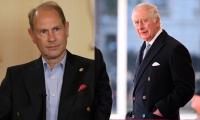Maulana Tariq Jameel said it best at the Supreme Court’s population conference: “Our judges are such [a] blessing as they keep doing what they aren’t responsible for. God Bless them”.
The prime minister said at the same conference (which brought together favoured political, judicial, professional and religious elites of the day) – while eulogising the CJP – that it was SC judgments that actually laid Naya Pakistan’s foundation. Had a lesser man made such an accusation out loud, he could be hauled in for maligning the judiciary and accusing it of partisanship.
The PM had said a day before that the military was squarely behind the PTI’s agenda. In response, the DG ISPR had suggested that it is marvellous that the military, judiciary and government are all marching hand-in-hand in pursuit of national objectives. And he has a point. Is this not what patriots and critics (of the traitor variety) have all been vying for: all three being on one page, holding hands, singing kumbaya?
Back in 2007, a dictator committed a folly: he got overambitious and crossed the ‘one-coup-per-dictator’ redline. While doing so he threw out the chief justice and when a majority of SC judges sided with the CJ, the dictator sacked all superior court judges and put them under house arrest. Pakistan has suffered decade-long dictatorship-democracy cycles since the 1950s, with dysfunctional democracy and dictators taking turns. The PPP and PML-N had taken turns during the 1990s, to be followed with Musharraf’s coup in 1999.
But the general wasn’t ready to hang his boots when it was democracy’s turn. He did the ‘this is not dictatorship but a better path to democracy’ routine in 1999, ‘revolutionary reform agenda’, followed by PCO and judicial endorsement of the dictator (along with permission to amend the constitution), the referendum and reintroduction of ‘clean’ politicos, constitutional amendment and a few years of smooth sailing. We came full circle in 2007. But then he launched a coup against the judiciary ie the military’s historical ally in legitimising coups.
There are various versions of what happened next. The starry-eyed version is that the nation had finally had enough. The inability of saviour models to foster change was obvious. People were finally ready to stand for rule of law and continuity of the democratic process. Thus emerged a new alliance in 2007: that of the people/civil society, the legal fraternity, free media, political parties etc. This progressive alliance stood against controlled democracy, controlled media and ordained outcomes in the name of justice.
The resistance against Musharraf stirred hope. Many of its champions believed they were fighting not to put anyone in power but for nothing less than rule of law and constitutionalism. While the restoration of judges came to be seen as the measure of its success, it was about a lot more. If the movement succeeded, the nation would overturn much of the received wisdom: that the state is more powerful than its people; the fallen never rise; the civil-military balance can never be fixed; holy cows can’t be held to account.
Pakistan seemed intoxicated by the revolutionary spirit, by Laal’s renditions of Jalib (‘main ne us se ye kaha’, ‘zulmat ko zia’, ‘umeed-e-seher’ etc), Iqbal Bano’s ‘hum dekhenge’ and later Aitzaz Ahsan’s ‘kal, aaj aur kal’ (especially the bit about ‘riyasat ho gi maa ke jaise’). Ordinary people were willing to endure batons and teargas, not out of loyalty to a party but out of the sense that an independent judiciary backed by the people and empowered to enforce rule of law across the board and hold holy cows accountable would change the nation’s fortune.
And then it happened. Musharraf had to go. The government of the day was forced to restore the judges. Laal was outside the Jang plaza in Islamabad singing Jalib. There was no organised concert. People just came out with families and kids to dance to ‘main nahin manta’ and celebrate a new dawn. The dictator was declared a usurper, the latest batch of PCO judges had to go, the NRO was thrown out, the Asghar Khan case was fixed for hearing, missing persons’ next-of-kin thought they now had a remedy.
And then the revolution began to die down. The SC thought it was more representative than the elected government and could delve into the executive’s domain. It wasn’t long before the restored SC led by CJ Iftikhar Chaudhry fell victim to populism and the curse of suo motus. The apex court now wanted to fix prices, have the last say in who got appointed to which executive position, called in politicos and bureaucrats to bend their ears, made observations that smeared reputations of those before the court, made media headlines and resulted in media trials.
It seemed like the CJP ran the country. Everything started and ended with the apex court. The CJP was the most widely covered public office holder in the country. Each morning the most lead stories in newspapers were about him. The insults, the media coverage and the populism had a method. It brought tremendous power to the person of the CJP. The Chaudhry Court conducted its proceedings such that they created consequences often without any need to render declaratory judgments. The populism and the SC’s contempt powers made the CJP infallible.
Truisms about judicial conduct (‘judges don’t speak, their judgments do’ or ‘judges court neither public controversy nor attention’) were a thing of the past. For once, we had a different saviour model where CJP was the saviour. He was the Teflon king – until, of course, the Arsalan Iftikhar-Malik Riaz row happened. No one asked him what became of judicial reforms, why he wasn’t attending to our broken court system or – while fixing everything else – why he wasn’t trying to fix the institution he sat atop which needed a whole lot of fixing.
Let’s now return to the less starry-eyed version about the lawyers’ movement. One-coup-per-dictator was a military redline. And so it wasn’t the nation but primarily the military that ran out of patience with Musharraf. General Kayani and the brass no longer saw Musharraf’s exit as an affront to the military. They were quite looking forward to it. It was time to return to the barracks for a while to rehabilitate the bond between the nation and its army. This version explains Kayani’s famed phone call during the long march that led to the restoration of the judges.
The generals probably didn’t mind the limelight CJP Chaudhry hogged. But his eagerness to declare Musharraf a usurper and push for a treason trial, the Asghar Khan case and commentary that shed light on the military’s political engineering, and sermons about missing persons (and forcing military agencies to produce a few half-dead folks in court on stretchers) created bad precedents and an impression that the military had lost its pre-eminence in the power hierarchy and could be held to account by a judiciary that had replaced it.
CJP Chaudhry was cut down to size with the Arsalan Iftikhar scandal. Like most men who convince themselves while in power (with the help of flatterers and sycophants surrounding them) that they are indispensible and will never retire, CJP Chaudhry’s conduct helped with his downsizing. General Raheel Sharif finally put to rest the momentary doubts regarding change of the military’s position in the power hierarchy. And, General Bajwa, his successor, has taken matters to their logical conclusion: the military, judiciary and government on one page.
As a historical matter, in the de-facto model, the military sat atop the power pyramid with the judiciary as a junior partner and the two came together to hold the ruling civilian regime to account when it grew too big for its boots. Probably for the first time we are witnessing a phase where the de facto has metamorphosed into the de jure. There is no troika, no tussle and no tug-of-war. The military-judiciary split of 2007 is behind us. The military, judiciary and ruling regime all understand where they stand in the hierarchy and act accordingly, at ease with themselves and one another.
As the DG ISPR has said, what is there not to like about this? Only if the media could now project this in a positive light, we would all live happily ever after in Naya Pakistan.
The writer is a lawyer based in Islamabad.
Email: sattar@post.harvard.edu
A representational image showing residents walking at a wholesale market in Karachi. — AFP/FileOnce again there is...
A representational image showing late Pakistani human rights activist and Supreme Court lawyer Asma Jahangir. —...
A representational image showing a security personnel sanding guard beside a ship carrying containers at Gwadar port....
A health worker administers polio vaccine drops to a child during a door-to-door polio vaccination campaign in Lahore,...
Armed militants of the banned Tehreek-e-Taliban Pakistan pose for a photograph in Orakzai Agency. —...
An aeroplane of the national flag carrier of Pakistan is seen in this file photo. — AFPWhile Pakistan considers...







